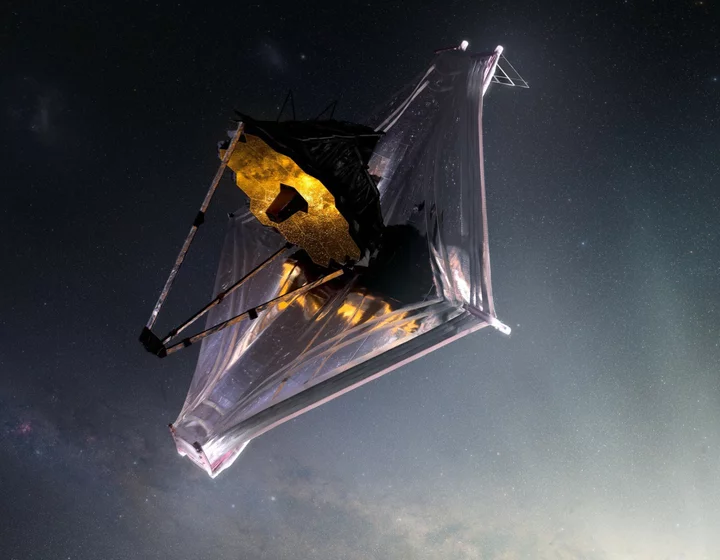Scientists aimed the mighty James Webb Space Telescope at one of the nearest galaxies to us, "NGC 6822."
It's a stunning sight, packed with an uncountable number of stars. NGC 6822, also called "Barnard's Galaxy," is part of our local group of some 25 galaxies (the Milky Way is one of the largest of the club). This local galaxy is relatively close at some 1.5 million light-years away, allowing the Webb telescope — the most powerful space telescope ever built — to see such stellar detail in this galactic close-up.
Webb's instruments operate at profoundly cold temperatures — minus 448 Fahrenheit or even lower — allowing them to capture a type of light (infrared) emitted by distant objects without interference from other nearby radiation sources, like the telescope's warm electronics.
"The power of Webb’s ice-cold infrared instruments and the incredible resolution of its primary mirror is necessary to examine stars hidden in dusty environments, and the results as shown here are spectacular," the European Space Agency, which runs the telescope with NASA and the Canadian Space Agency, explained.
SEE ALSO: Webb telescope just made tantalizing find on ocean world EuropaHere's what you're seeing in the new Webb telescope image:
- Incredible star field: Almost every spot or dot you see in this image is a star. The brightest stars are shown in cyan or pale blue, while the farther-away stars are seen in warmer colors like orange, yellow, and red.
- Blue orb: At left-center in the image, to the left of clouds of reddish gas, is a bright blue orb. This is a large cluster of stars called a "globular cluster."
- Hidden galaxies: If you peer closely, you can make out tiny galaxies in the distant background of the star field. For example, one is a spiral galaxy located near the top left corner of the image.
A dense star field in the relatively near galaxy NGC 6822. Credit: ESA / NASA / CSA / M. MeixnerNGC 6822 is notably different than our Milky Way galaxy, a spiral galaxy with arms. Instead, NGC 6822 is a "dwarf irregular galaxy," which can take odd shapes like toothpicks or rings. NGC 6822 looks like an irregular bubble composed of millions and millions of stars.
The Webb telescope's powerful abilities
The Webb telescope is designed to peer into the deepest cosmos and reveal new insights about the early universe. But it's also peering at intriguing planets in our galaxy, along with the planets and moons in our solar system.
Want more science and tech news delivered straight to your inbox? Sign up for Mashable's Light Speed newsletter today.
Here's how Webb is achieving unparalleled feats, and likely will for decades:
- Giant mirror: Webb's mirror, which captures light, is over 21 feet across. That's over two and a half times larger than the Hubble Space Telescope's mirror. Capturing more light allows Webb to see more distant, ancient objects. As described above, the telescope is peering at stars and galaxies that formed over 13 billion years ago, just a few hundred million years after the Big Bang.
"We're going to see the very first stars and galaxies that ever formed," Jean Creighton, an astronomer and the director of the Manfred Olson Planetarium at the University of Wisconsin–Milwaukee, told Mashable in 2021.
- Infrared view: Unlike Hubble, which largely views light that's visible to us, Webb is primarily an infrared telescope, meaning it views light in the infrared spectrum. This allows us to see far more of the universe. Infrared has longer wavelengths than visible light, so the light waves more efficiently slip through cosmic clouds; the light doesn't as often collide with and get scattered by these densely packed particles. Ultimately, Webb's infrared eyesight can penetrate places Hubble can't.
"It lifts the veil," said Creighton.
- Peering into distant exoplanets: The Webb telescope carries specialized equipment called spectrometers that will revolutionize our understanding of these far-off worlds. The instruments can decipher what molecules (such as water, carbon dioxide, and methane) exist in the atmospheres of distant exoplanets — be they gas giants or smaller rocky worlds. Webb will look at exoplanets in the Milky Way galaxy. Who knows what we'll find?
"We might learn things we never thought about," Mercedes López-Morales, an exoplanet researcher and astrophysicist at the Center for Astrophysics-Harvard & Smithsonian, told Mashable in 2021.
Already, astronomers have successfully found intriguing chemical reactions on a planet 700 light-years away, and the observatory has started looking at one of the most anticipated places in the cosmos: the rocky, Earth-sized planets of the TRAPPIST solar system.









